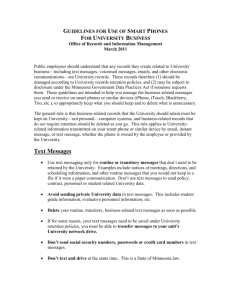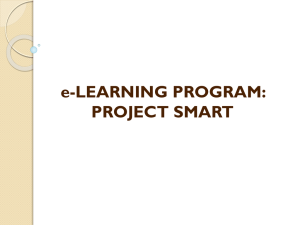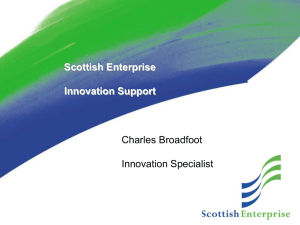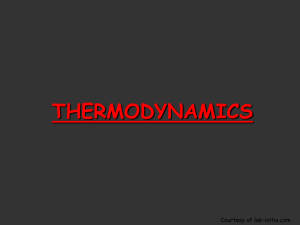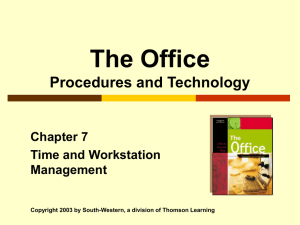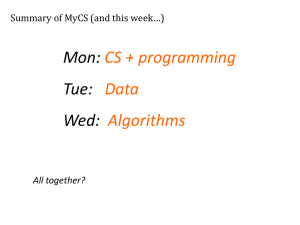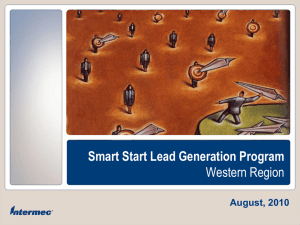点击下载浏览该文件201052213597610
advertisement
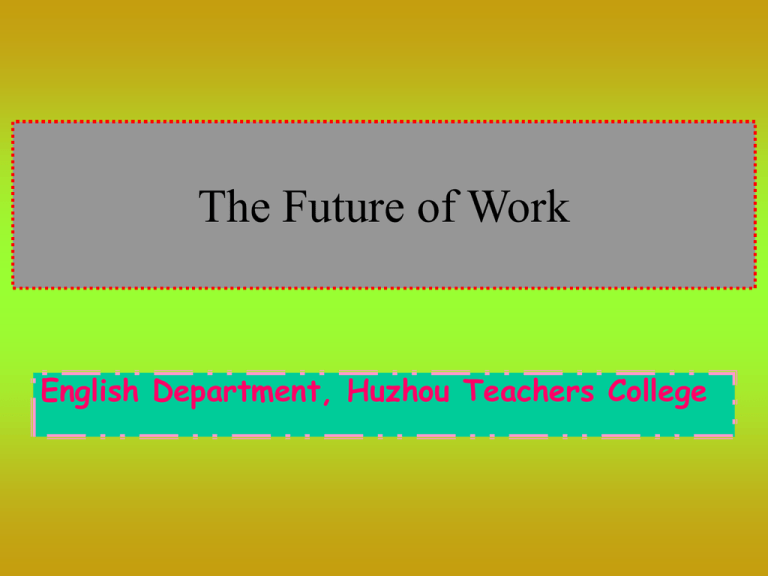
The Future of Work English Department, Huzhou Teachers College Objectives 1) To enable students to talk about changes in working practices. 2) To read an extract about work in the future and discuss the issues involved. 3) To use one of the diagrams to find out about each other’s working environment. Tasks and Schemes 1. Reading one. 25’ 2. Speaking one. 30’ 3. Assignment. Reading on page 44: I. Difficult points: 1) MAS:Micro Analog System.芬兰微电 子模拟系统公司 It was made up of three Finland companies: Nokia, Aspo and Salora in 1980. 2) Governments will find it difficult to collect revenue from workers and companies. taxes 3) In future, work space will become less rigid, with hotdesking being the norm. (of a person or his character or opinion) firm, fixed, not easy to change. The system of turning to use a desk. The staff have been divided into groups shifts to work so that they can use the same computer, desk and office respectively. 办公 桌轮用 4)To offer service around the clock. All day and all night without stopping. 5)…recognizing when staff are overtaxing themselves. 及时觉察员工的过 度劳累现象。 To force beyond a limit. 使(劳累过度) 6)Institute of employment studies 就业研究机构 7)We’re bound to see a move towards promoting lifestyle issues in the office. 我们将来在工作场所一定会高 度重视生活方式问题。 Smart 一词与不同的名词搭配有不同的含义,如:a smart student聪明的学生,a smart businessman精明的 商人,a smart uniform笔挺的制服,a smart new suit 潇洒的新西装,smart companies有远见的公司。 8)Smart firms are already pushing these responsibilities up the agenda.(2) Push …up the agenda 把…摆到议事日程上 9)Many people prefer to improve their CVs and move on to another company other than get stressed out in their current job.(4) Very tense and anxious because of difficulties in their lives 因为生活中遇到种种困难而高度紧 张焦虑。 网络办公系统公司经理 10)Director, Cyber office. Cyber 常做词缀用,这里指“电脑、网络”。构词 有:cyber-cafe网吧,cyber-century电脑世纪,cybercommunity网络社团,cyber-concert电脑音乐,cyberculture电脑化社会/电脑文明,cyber-mall电脑商场, cybernate使电脑化,cyber-space网络空间,cyberspeak网络用语。这类词被统称为C-words. II. Match each of the statements with one of the managers’ opinions. Jeanne Desaill (4) Joshua Golder(3.7) Megan O’ Riordan (1,6) Janice Watson (5) Scott Forrest (2,8) III. Which of them do you agree with after reading the material? 湖滨地区 Observe the radar charts on page 46. Look at the results of a survey about how residents adapted to working at Waterside in the first twelve months. How did the move change working conditions for BA staff? British Airways 英国航空公司 • Radar chart / diagram: a kind of chart for economic analysis, whose name comes from it’s figure like the shape shown in radar screen. This chart is usually used to compare and analyze multiply factors and their relevant factors within a system. Generally it can be divided into many stages according to the percentages, such as 20%, 40%, 60%, 80%, 100%; the diagonal lines (对角线) separate the field into many vectors (相关因素区域象限或 向量) illustrating different conditions of a system or a thing. • Chart / diagram caption (A title, short explanation, or description accompanying an illustration or a photograph. • Caption:标题,说明文字: 为插图或照片配的标题、短小 说明或描述): 1) Firstly, the broken lines(虚线)in the chart show the conditions of work pre-Waterside: except that the condition of work in the aspect “can obtain information to do my job” is 40%, those in the rest seven aspects, “can contact people I need to easily, can do confidential work easily, surroundings help me concentrate, do not waste time duplicating work, surroundings foster sense of team, surroundings help informal meetings, can contribute to discussions”, are all about 60%. 2)Secondly, the solid lines show the conditions of work post-Waterside: those in the aspect “can do confidential work easily” is about 40%; those in both “surroundings help informal meetings” and “can contribute to discussions” are about 80%; those in the rest five aspects are above 60%. Diagram caption: 1) Firstly, the broken lines show the conditions of office environment preWaterside: those in four aspects——can print when I need to, storage space is accessible (Easily obtained), can photocopy when I need to, can fax when I need to——are all over 80%; those in the rest six aspects are about 80%. 2)Secondly, the solid lines show the conditions of office environment postWaterside: those in four aspects —— can print when I need to, can fax when I need to, workstation meets needs, workstation is comfortable——are all over 80%; those in two aspects—— voicemail is effective, voicemail is easy to use——are about 60%; those in the rest aspects are about 80%. Compare and analyze the vectors and then conclude: Vectors:相关因素区域象限或向量) 1) Based on the comparison and analysis of conditions Pre-Waterside and Post-Waterside shown in the radar chart, the move has changed working conditions for BA staff in some aspects. 2)In the way they work, there have been big improvements in aspects such as “surroundings help informal meetings” “can contribute to discussions” and “can obtain information to do my job”. 3) The change is mostly felt in “can obtain information to do my job” and “can do confidential work easily”, with the former improving by 20% for 40% to over 60% and the latter degenerating (To decline in quality: 退化,变质:在质量方面下降)by 20% from 60% to below 40%. 4) There is not much change in other aspects. 5) In office environment, the move has brought about positive changes to the following three aspects, namely, “Workstation meets needs”, “Workstation is comfortable” and “Can photocopy when I need to”. They have improved by 20%. 6) On the other hand, working conditions concerning “Voicemail is effective”, “Voicemail is easy to use” and “Can print when I need to” are not as good as before. Assignment: collect relevant information on e-business. Thank U 4 your attendance!
